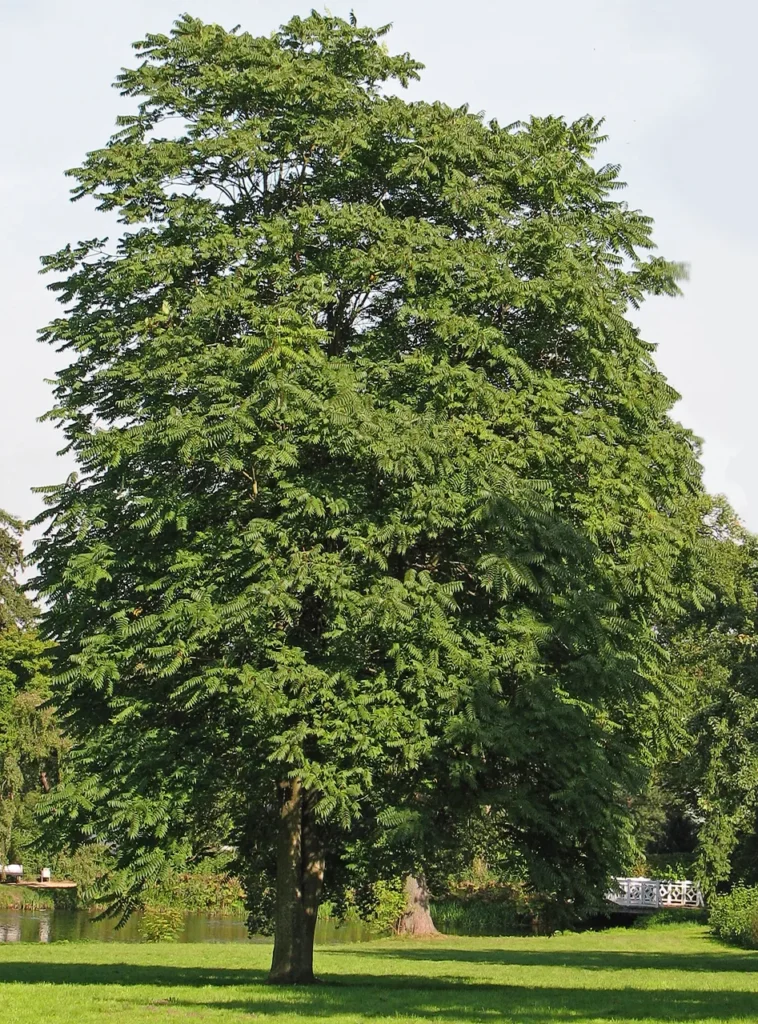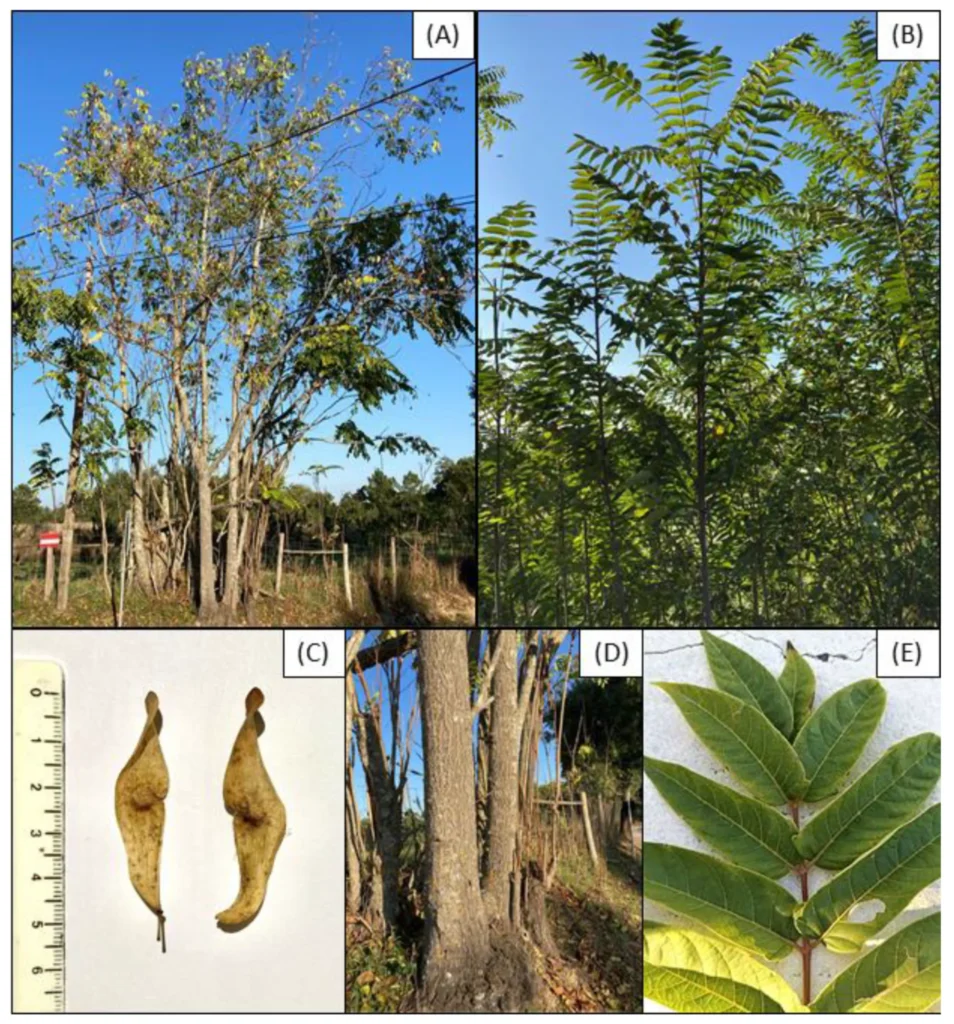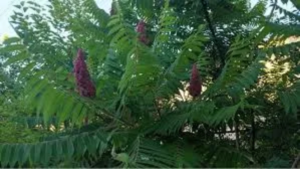Is the Tree of Heaven a blessing or a curse? Discover its history, problems, and how to manage this controversial species.
Introduction: The Tree of Heaven
With a name like “Tree of Heaven”, you’d expect something majestic and benevolent. But the reality is far more complex. This fast-growing tree, native to China, has a long, strange history in the US. Initially loved for its beauty, it’s now considered an invasive menace. Let’s explore this fascinating, problematic plant in detail.
Tree of Heaven – A Brief Overview
- Scientific Name: Ailanthus altissima
- Appearance: Tall, deciduous tree with large, feathery leaves and a smooth, gray bark. In summer, it produces clusters of greenish-yellow flowers that can have an unpleasant odor (more on that later).
- Growth Rate: Extremely fast, hence its popularity when introduced to the US in the 1700s.
What Makes the Tree of Heaven Stand Out?
Rapid Growth and Reproduction
The Tree of Heaven is known for its astonishing growth rate and ability to reproduce both sexually through seeds and asexually via root suckers. This adaptability allows it to quickly dominate landscapes, outcompeting native flora for resources.
Distinctive Features
Characterized by its large, compound leaves, smooth bark, and towering height, the Tree of Heaven can easily be mistaken for a benign giant. However, its beauty is overshadowed by the problems it brings.
Why is the Tree of Heaven a Problem?
The invasive nature of Ailanthus altissima poses significant threats to native ecosystems. It releases allelopathic chemicals that inhibit the growth of surrounding plants, leading to reduced biodiversity. Moreover, its dense thickets disrupt wildlife habitats and its robust root system can damage urban infrastructure.
Where is the Tree of Heaven Located Now?
Originally from Asia, the Tree of Heaven has spread across most of the United States, thriving in urban, suburban, and rural areas alike. It is particularly prevalent along roadsides, in abandoned lots, and disturbed lands where it faces little competition.
The Unpleasant Aroma
One of the tree’s most notable characteristics is the strong, offensive odor emitted by its crushed leaves and flowers, often compared to burnt peanut butter or rotten nuts. This smell is a defense mechanism against herbivores but also serves as a deterrent to human appreciation.
Tree of Heaven or Tree of God?
While “Tree of Heaven” is its common name, no tree is officially known as the “tree of God.” However, the reverence this tree once held in its native habitat contrasts starkly with the problematic nature it exhibits abroad.
The Story Behind the Tree of Heaven
The Tree of Heaven’s journey from a cherished ornamental to an invasive pest reflects human intervention in natural ecosystems. Its story is a cautionary tale about the unforeseen consequences of introducing non-native species into new environments.
Battling the Tree of Heaven
Chemical and Mechanical Control
Controlling the spread of Ailanthus altissima is challenging. Herbicides and mechanical removal can be effective but require persistent effort and can be costly and environmentally damaging.
Biological Control: A Glimmer of Hope?
Recent research has focused on biological control methods, such as introducing specific fungi or insects that target the Tree of Heaven without harming native species. These methods offer a more sustainable solution but are still in the experimental phase.
Why the Love-Hate Relationship?
The Good
- Adaptability: Thrives in poor soil, polluted areas, and urban environments. This made it a popular choice for landscaping in harsh conditions.
- Hardiness: Resistant to disease, insects, and drought.
- Aesthetic: Its tropical appearance and rapid growth provided quick shade and greenery.
The Bad
Aggressive Spread: Produces vast amounts of seeds and spreads through root suckers, forming dense colonies that choke out native plants.
Toxicity: All parts of the tree contain a chemical which inhibits the growth of other plants around it.
Structural Weakness: The wood is weak and brittle. Branches break easily, causing property damage during storms.
Foul Odor: Male flowers produce an unpleasant smell often described as rotting peanuts.
What are the negative impacts of the tree-of-heaven on the environment?
The Tree of Heaven (Ailanthus altissima) has several negative impacts on the environment, primarily due to its invasive nature and aggressive growth characteristics. Here are the key environmental issues associated with this species:
- Competition with Native Species: The Tree of Heaven is highly competitive and can outcompete native flora for essential resources such as sunlight, water, and nutrients. This competition can lead to the displacement of native plant species, reducing biodiversity and altering habitats.
- Allelopathic Effects: This tree releases chemicals into the soil through its roots and decaying leaves, which inhibit the growth of surrounding plants. This allelopathic activity can severely affect the regeneration of native species and alter the ecological balance of the areas it invades.
- Physical Infrastructure Damage: The robust and aggressive root system of the Tree of Heaven can cause significant damage to human-made structures. It can break through pavement, damage building foundations, and block sewer systems, leading to costly repairs and maintenance.
- Impact on Wildlife: By displacing native plants, the Tree of Heaven also affects the fauna that rely on indigenous plant species for food and habitat. This can lead to a decrease in wildlife populations and a loss of biodiversity.
- Host for Invasive Species: The Tree of Heaven serves as a host plant for the Spotted Lanternfly (Lycorma delicatula), an invasive pest that causes significant damage to agriculture, including crops and hardwoods. The presence of the Tree of Heaven facilitates the spread of this pest, compounding its environmental impact.
- Resistance to Control Measures: Due to its ability to resprout vigorously from roots and stumps, controlling the spread of the Tree of Heaven is challenging and often requires repeated chemical treatments or mechanical removal, which can be both costly and labor-intensive.
Given these impacts, managing the spread of the Tree of Heaven is crucial to protecting native ecosystems and reducing economic costs associated with its control and the damage it causes. For those looking to replace the Tree of Heaven, native species that are less aggressive and more beneficial to local wildlife are recommended. Suitable replacements could include native hardwoods like oaks or maples, which provide habitat and food for a variety of wildlife while also enhancing the local landscape.
How can the tree-of-heaven be controlled or removed?
Controlling or removing the Tree of Heaven (Ailanthus altissima) can be challenging due to its aggressive growth and reproductive strategies. However, several methods have been identified as effective in managing this invasive species:
Mechanical Removal
- Cutting or Mowing: This method involves cutting down the tree as close to the ground as possible. However, cutting alone often results in vigorous resprouting from the stump and roots, making the situation worse unless followed by herbicide application.
- Hand Pulling: Effective for young seedlings, especially when the soil is moist, ensuring the entire root system is removed to prevent regrowth. This method is impractical for older or larger trees due to their extensive root systems.
Chemical Control
- Herbicide Application: Systemic herbicides are the most effective chemical control method. They are absorbed by the foliage or cuts in the bark and transported throughout the plant, including the roots. The best time for application is mid to late summer (July to September), when the tree is actively translocating nutrients to its roots.
- Foliar Spray: Used for smaller trees or where precise application is possible to avoid affecting nearby desirable vegetation8.
- Basal Bark Treatment: Involves applying herbicide directly to the bark. This method is suitable for trees with a diameter less than 6 inches.
- Hack-and-Squirt: Involves making cuts into the bark and injecting herbicide. This method is effective for larger trees and helps ensure the herbicide reaches the vascular system.
- Cut-Stump Treatment: After cutting the tree, herbicide is immediately applied to the fresh cut of the stump. This prevents resprouting but may not effectively control root suckering unless followed up.
Biological Control
- Biological Agents: Research is ongoing into biological control options such as the use of specific insects or pathogens that target the Tree of Heaven without affecting native species. For example, the mite Aculus mosoniensis and the fungus Verticillium nonalfalfae have shown promise in preliminary studies.
Integrated Pest Management (IPM)
- Combining Methods: Often, a combination of mechanical and chemical methods yields the best results. For instance, cutting followed by immediate herbicide application to the cuts can be effective. Monitoring and follow-up treatments are crucial to address any resprouting or new growth.
Environmental and Safety Considerations
- Always follow label directions and safety precautions when using herbicides.
- Consider the potential impact on non-target plants and animals.
- In areas where chemical use is restricted or if you prefer non-chemical methods, mechanical removal followed by diligent monitoring and follow-up may be necessary.
Conclusion
Successfully controlling the Tree of Heaven requires persistence and often multiple approaches over several seasons. Early detection and rapid response are key to preventing establishment and spread. After removal, replanting with native species can help restore natural habitats and prevent re-infestation by providing competition.
Are there any benefits to the tree-of-heaven?

Yes, there are several benefits associated with the Tree of Heaven (Ailanthus altissima), despite its reputation as an invasive species. These benefits span medicinal, ecological, and industrial uses:
- Medicinal Uses: The Tree of Heaven has been used in traditional medicine for various health conditions. The dried bark from the trunk and root is used to treat ailments such as diarrhea, asthma, cramps, epilepsy, fast heart rate, gonorrhea, and other conditions3. Additionally, extracts from the tree have shown potential in scientific studies for their anti-inflammatory, antioxidant, antimicrobial, and neuroprotective properties.
- Ecological Uses: Although invasive, the Tree of Heaven can thrive in harsh urban environments where other trees might not survive. It has been used to re-vegetate areas where soil conditions are poor, such as regions affected by acid mine drainage. Its ability to grow in polluted environments makes it a candidate for urban greening projects.
- Industrial Uses: In manufacturing, the Tree of Heaven is used as an insecticide. Its rapid growth and high biomass production also make it a potential source for biofuel.
These benefits, however, are often overshadowed by the environmental challenges posed by the tree’s invasive nature, which can lead to significant ecological disruptions. Therefore, while the Tree of Heaven does have beneficial uses, managing its spread to prevent ecological harm is crucial.
What are the medicinal benefits of the tree-of-heaven?

The Tree of Heaven (Ailanthus altissima) offers various medicinal benefits, which have been recognized in traditional medicine across different cultures, particularly in Asia. Here are some of the key medicinal uses and benefits of the Tree of Heaven:
- Gastrointestinal Ailments: The bark of the Tree of Heaven has been used traditionally to treat various gastrointestinal issues such as diarrhea, dysentery, and intestinal bleeding. It is known for its astringent properties, which help in reducing inflammation and controlling bleeding.
- Respiratory Conditions: The tree has been used to treat respiratory ailments like asthma and cough. Its antispasmodic properties help in relieving cough and its anti-inflammatory properties aid in reducing inflammation in the respiratory tract.
- Antimicrobial and Antifungal Activities: Extracts from the Tree of Heaven have shown antimicrobial and antifungal properties, making it useful in treating infections caused by microbes and fungi.
- Anti-inflammatory and Analgesic Properties: The tree’s extracts have been found to possess anti-inflammatory and analgesic properties, useful in treating pain and inflammation in various conditions.
- Neuroprotective Effects: Studies have indicated that the bark of the Tree of Heaven might have neuroprotective properties, potentially beneficial in treating neurological disorders such as epilepsy.
- Antipyretic (Fever Reducing) Effects: The tree has been used traditionally to reduce fever, thanks to its antipyretic properties.
- Cardiac Benefits: The root bark of the Tree of Heaven has been used in treating cardiac palpitations and other heart-related conditions due to its cardiac depressant properties.
- Antiparasitic Properties: The tree has been used as a vermifuge to treat parasitic worm infections. It is particularly noted for its effectiveness against tapeworms and other intestinal parasites.
- Antioxidant Properties: The tree contains compounds with antioxidant properties, which help in combating oxidative stress and may contribute to overall health.
- Cancer Treatment Potential: Some chemicals found in the Tree of Heaven might have effects against cancer cells, although more research is needed to fully understand and utilize these properties.
These medicinal uses highlight the Tree of Heaven’s potential in traditional and possibly modern medicine, despite its invasive nature in non-native environments. However, it is important to note that while the tree has various medicinal benefits, it should be used with caution due to potential side effects such as nausea and dizziness, especially when taken in large amounts.
How is the tree-of-heaven used in manufacturing?
The Tree of Heaven (Ailanthus altissima) has several applications in manufacturing, primarily due to its rapid growth and the properties of its wood and chemical extracts. Here are some of the notable uses of the Tree of Heaven in manufacturing:
- Wood Products: The wood of the Tree of Heaven is lightweight and relatively soft, which makes it suitable for manufacturing lightweight furniture, crates, and pallets. Its wood is also used in the production of plywood and fiberboards. Due to its rapid growth, the tree can be harvested within a few years, making it an economically attractive option for wood products that do not require high durability or strength.
- Textile Industry: The bark and wood of the Tree of Heaven can be processed to produce a fiber known as China grass, which is used in making ropes, paper, and cloth. This fiber is particularly valued in regions where the tree is native or well-established.
- Biofuel Production: Due to its fast growth rate and high biomass yield, the Tree of Heaven is considered a potential source for biofuel production. The tree can be processed into pellets or biochar, which can be used as a renewable energy source. Its ability to grow in poor soil conditions without extensive agricultural inputs also makes it an attractive candidate for bioenergy crops.
- Natural Insecticide: The Tree of Heaven contains several chemical compounds that have insecticidal properties. These compounds can be extracted and used to produce natural insecticides. This application is particularly valuable as it offers an environmentally friendly alternative to synthetic chemical insecticides.
- Tannin Extraction: The bark of the Tree of Heaven is rich in tannins, which can be extracted and used in the leather tanning industry. Tannins are important in the process of converting animal hides into durable leather, and the high tannin content of the tree’s bark makes it a useful resource for this industry.
- Dye Production: The tree can also be used in the production of dyes. The bark and leaves contain compounds that can be processed into natural dyes for textiles, offering sustainable alternatives to synthetic dyes.
These diverse applications demonstrate the Tree of Heaven’s potential utility in various manufacturing sectors. However, its invasive nature should be carefully managed to prevent ecological damage while harnessing its industrial benefits.
Conclusion:
The Tree of Heaven, with its deceptive name, serves as a stark reminder of the complexities and unintended consequences of introducing non-native species into new environments. While its eradication poses significant challenges, ongoing research and community efforts provide hope for controlling its spread and mitigating its impact on native ecosystems.
